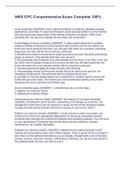Exam (elaborations)
AWS CPC Comprehensive Exam Complete 100%
- Course
- Institution
cloud computing -ANSWER the on-demand delivery of compute, database storage, applications, and other IT resources through a cloud services platform via the internet with pay-as-you-go pricing (kind of like renting someone's computer. Think of the electricity bill. You are only charged for the powe...
[Show more]



